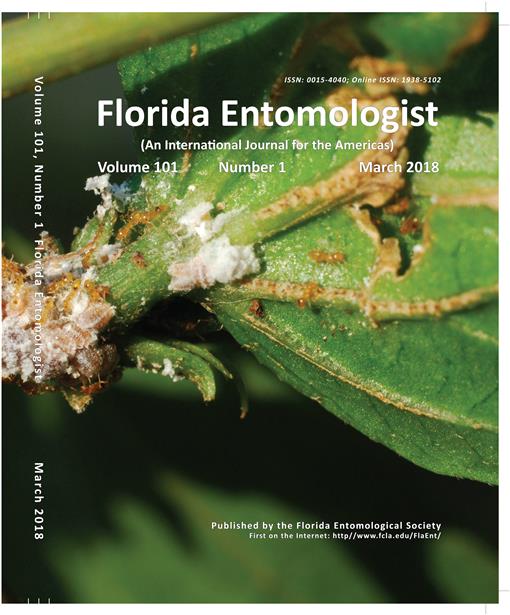Plagiolepis alluaudi, of Madagascar origin, is an invasive ant species in many tropical localities around the world. Here we report the first record of an established population of P. alluaudi in the continental Americas. This established population is thriving in a neighborhood of Fort Lauderdale, Florida, USA, and it raises concerns that this new invader may become another pest in the crowded landscape of Florida's invasive ant fauna. Taking into account the local densities of this ant in the area, it is possible that it was established for several years before being detected. It has the potential to be a household nuisance, and may also have an impact on urban ecosystems of southeastern Florida. It is expected that its own movement and human activity will further spread P. alluaudi beyond its current range.
South Florida is home to a broad spectrum of invasive flora and fauna owing to its tropical climate, its status as an international yachting and tourist destination, and plant material brought in through international commerce (Chouvenc et al. 2016). Invasive ants constitute an important subset of non-native terrestrial arthropods. In fact, all of Florida's pest ants listed by Klotz et al. (1995) are either known to be exotic species or are “dubious natives” according to Deyrup et al. (2000). We herein report the establishment of Plagiolepis alluaudi Emery (Hymenoptera: Formicidae) in South Florida, which constitutes the first continental New World record of this ant.
In early 2017, foraging workers and queens of P. alluaudi were observed by TC in the Riverland neighborhood of Fort Lauderdale, Broward County, Florida (about 26.1000 °N, 80.1800 °W). The ants were feeding on the nectar of Zingiber zerumbet (L.) (cv. shampoo ginger) flowers (Zingiberaceae). For more than a decade, Pheidole megacephala (F.) (Hymenoptera: Formicidae) was the dominant ant species in this area (T. Chouvenc, personal observation). Over a period of 6 mo, the P. megacephala populations were seemingly displaced by a minute yellow ant, and in addition to foraging for nectar, they were observed tending aphids and feeding on dead insects. In Jul 2017, a large group of foragers and queens invaded a Riverland household and, in response, we sought its identification.
Based on sight identification, preliminary candidates included a Brachymyrmex spp. and Tapinoma litorale Wheeler (both Hymenoptera: Formicidae). However, after consulting a current review of Florida ants (Deyrup 2016) and taxonomic references (Sarnat 2008; AntWiki 2017), the ant was identified by JW as P. alluaudi. Smith's (1957) redescription of P. alluaudi perfectly matched the morphology of the workers. The photographs in Wetterer (2014) also were a match (Fig. 1). Finally, specimen identity was confirmed by a foremost authority on Florida ant taxonomy (M. Deyrup, personal communication).
Smith (1957) and Wetterer (2014) provided a full background on the distribution, morphology, and habits of P. alluaudi, with records therein suggesting an origin in Madagascar. Wetterer (2014) lists several islands in the Lesser Antilles (Barbados, St. Lucia, Grenada, Anguilla, St. Martin, St. Kitts, Nevis, Guadeloupe, and Martinique) and in Bermuda (Wetterer 2017) as occupied by P. alluaudi. A few additional invasive establishments of P. alluaudi include Capricorna Cays, Australia (Hoffmann & Kay 2009); ‘Top End’, Northwest Territory, Australia (Andersen et al. 2016); and Nansei Islands, Japan (Harada et al. 2015).
Subsequent surveys within the Riverland area confirmed that P. alluaudi forages in relatively high densities across several residential blocks. Given the infested area, it is possible that it was established for several years before being detected. Nests with brood were readily detected in dead branches of vegetation, both on living trees and on twigs on the soil surface. A partially decomposed section of a tree branch as little as 10 cm long and 2 cm diameter can host several thousand ants, including brood and several queens (Fig. 2). Detailed monitoring will be necessary to determine the current and future range of P. alluaudi in Florida and its effects on local ants and other insects. The establishment of P. alluaudi in an area previously dominated by P. megacephala populations supports Le Breton's (2003) observation on the interaction of these 2 species in New Caledonia.
Fig. 1.
Dorsal (A) and lateral (B) views of the worker and lateral view (C) of the queen of Plagiolepis alluaudi collected in the Riverland neighborhood of Fort Lauderdale, Florida, USA.

The household invasion noted above originated from garden populations entering the structure in a relatively dense trail of workers, and included supernumerary queens foraging openly on the kitchen countertop and feeding on pet food. Three hours after application, baiting with a borate and sugar solution elicited feeding by several dozen queens and thousands of workers within the bait tube. Two days after the installation of the bait tubes, the P. alluaudi activity ceased indoors, while the ants were still active in the garden. Subsequent structural infestations were observed in the weeks following treatment, showing limited impact of the bait on the overall surrounding population.
Deyrup (2016) suggests that most exotic ants arrived in Florida in plant containers or plant materials, or as ship stowaways. His insightful prediction that P. alluaudi “might someday appear in Florida” fits well with the suspected modes of entry he puts forth. The Riverland area of Fort Lauderdale is interwoven with waterways dockage for yachts and sailboats which call on ports throughout the West Indies, the Caribbean Basin, and beyond. Although private seagoing vessels contain orchids and other decorative plants, the availability of food, water, and harborage may be more important for sustaining ant colonies much as they are for invasive termites (Scheffrahn & Crowe 2011). We therefore suspect that the location of the first record of P. alluaudi close to maritime vessels and dockage may not be a coincidence. Because this ant species can easily nest in small vegetative debris, it easily can be transported to new locations by waste management services of local yard wastes, and by the commercial movement of plant material. Its spread throughout South Florida is therefore very likely in the near future.






